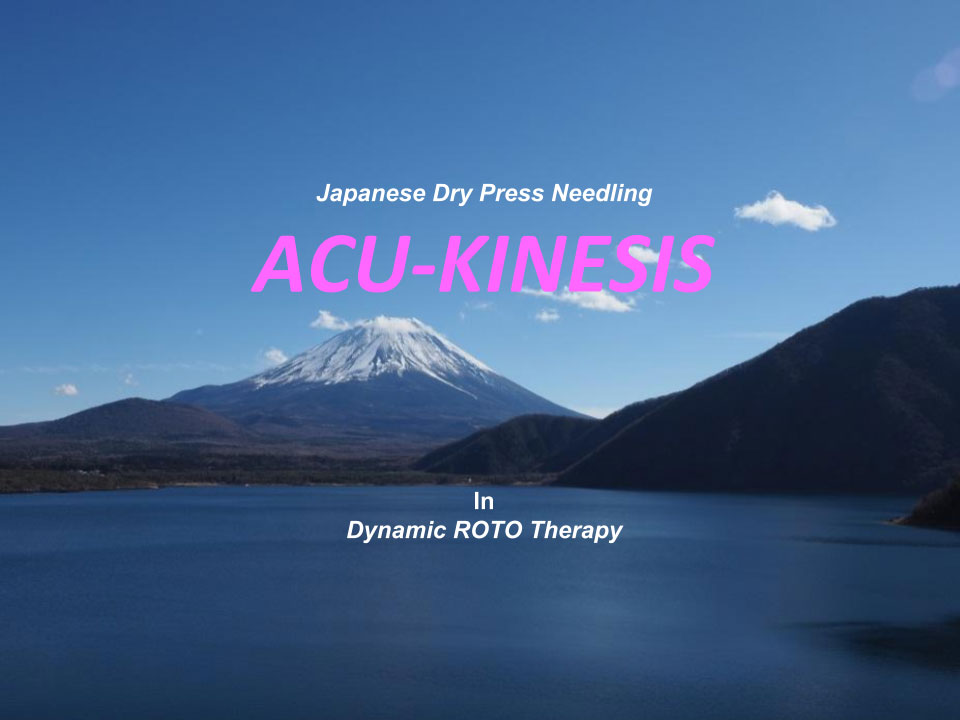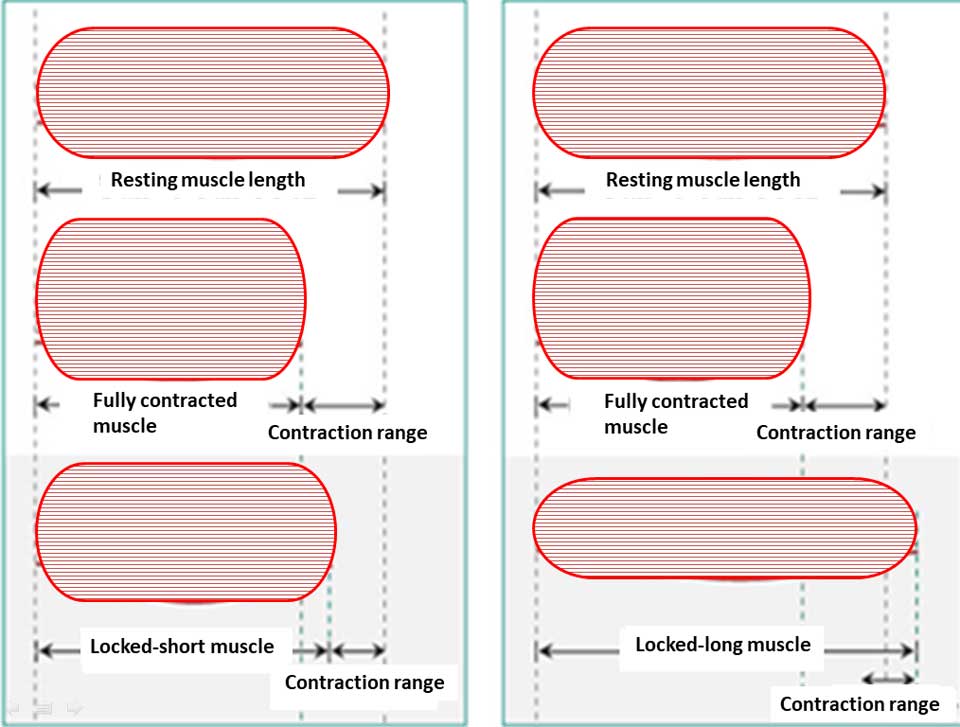
Any impairments to the rotational kinetic chain stemming from problems with fascia are treated with press needles alone as part of the whole acupuncture – with – motion therapy which we call ACU-KINESIS.
The press needles solely used in ACU-KINESIS are only up to 2mm long. This helps to ensure minimal stimulation upon insertion. (Dia.13, 14, 15).
In the US for example, the use of “Dry Needling” in conventional clinical practice has spread significantly in recent years. The name “Dry-Press Needling” has since been chosen in ACU-KINESIS as there are similarities in treatment methods.
In selecting differing press needles for skin insertion (depending on the type of muscle contraction apparent), coupled with rotational manipulation, ACU-KINESIS targets the network system between skin and the deeper layers of fascia to help the body`s powers to heal and rejuvenate itself.
As well as helping with musculoskeletal injuries, it`s effectiveness with a wide array of unhealthy states clearly shows it`s potential as part of a holistic treatment.
1. Muscle contraction and ACU-KINESIS
In addition to highlighting just the effects of acupuncture on the skin, ACU-KINESIS further makes use of the effects muscle contraction during insertion has. While the mechanics of needle insertion may be similar in many cases , differences in muscle contraction help to greatly vary the outcomes of each individual treatment.
The norm for clinical acupuncture is for the treatment area to be relaxed. If, however, the muscle, the fascia or the skin were to be otherwise, say taught or contracted then the effects of acupuncture will differ. For ACU-KINESIS we purposely make the area taught and contracted to suit the needs of the treatments.
When a muscle is tensed, it is done in one of two ways. i.e. Locked- Short or Locked-Long (as in dia.16). The mechanism at work in each of these two patterns is intrinsically different.
For example, with upper-crossed syndrome with tight shoulders with a forward-head posture (dia17) the muscles of the anterior chest become shortened and tight (ie. locked short) thus reducing ROM. The shoulder back muscles, however, are locked-long (ie. in a constant state of extension) where the muscle no longer has the ability to contract.
For the muscles of the anterior chest that are locked-short, the purpose of treatment would be to promote ROM by stretching while, for the locked- long shoulder and back muscles, we must get them to regain their ability to fire up and contract again.
By externally rotating and abducting the shoulder and then repeat flexion and extension concentrically we can widen the ROM for the anterior chest muscles that are locked-short. In the latter case, the shoulder and back muscles are tensed when needled and then eccentric contraction is repeated to enable the muscles to better fire and contract.
In the former method, concentric stretches are conducted after needling and so the process is called Concentric ACU-KINESIS . For the latter, eccentric stretches after needling is done so we call this method Eccentric ACU-KINESIS . These two methods can be used sometimes independently and sometimes together depending on the symptoms being treated.
2. Method of Concentric ACU – KINESIS & Eccentric ACU – KINESIS
For Concentric ACU-KINESIS treatment of points of the skin surrounding muscles or fascia that are locked short, we must first relax the area and open up the joints as much as possible to try to regain the optimal length of the muscle or fascia . Symptoms or conditions most suited for this entail areas that are restricted in their ability to extend e.g. in cases of acupuncture of the lower back for flexion restriction of the hips in cases of lumbago or, for cases of neck pain with restriction in lateral flexion of the neck to the left, we needle the right side of the neck.
〔Method of Needling〕 We first stretch the muscle, fascia and skin of the area concerned and then insert the needle. While retaining the needle we; Concentrically contract → extension → concentrically contract → extension → remove the needle in the extended position(dia.18,dia19).
Effect: Eradication of pain felt upon extension. Increased ROM, lightened felling and reduction in any fatigue.
Side-Effects: Feeling of lethargy and temporary loss of muscular pain.
The aim of Eccentric ACU-KINESIS (Dia.20, 21)is to get the muscles or fascia and meridian points on the related area of skin that are found to be locked-long to, once again, contract fully and powerfully.
Problematic symptoms exist when the ability to flex or contract is impaired. For example, acupuncture for lower back pain with hyper-extension of the torso. Also, with lateral flexion of the neck to the left, we perform acupuncture to the same left side of the neck.
Effective for eliminating pain on contraction. It becomes easier to fire up the muscles. Greater stability and grounding.
Side-Effects : the area treated can feel heavy but no reduction in strength occurs.
By incorporating Concentric and Eccentric methods of treatment we are not only better able to approach muscular and skin problems with acupuncture but, what`s more, fine tune our selection of ACU-KINESIS based on clear differences seen in the type of muscular contraction.
Dia.22 shows the relationship between the optimal acupuncture methods with different types of muscular contraction. Correct use of these different methods coupled with the rotation stretches that promote smoother movement of the soft tissues ensures quality ACU-KINESIS treatments.
3. ACU-KINESIS Guidelines
When using ACU-KINESIS in practice we must adhere to some basic rules. If we are able to stick to these five steps when treating patients, then a positive therapeutic effect is guaranteed.
1) Depth Of Needling
For proximal areas of the body needle deeper while for distal points needle shallow. Press needles come in five different needle lengths and we select different types accordingly.
2) The Order In Which We Needle Points
For Clinical effect our main aim is to promote the kinetic chain. With this in mind, the order in which needling is performed is to start distally and move towards or in the direction of the area(s) of the body with the impairment of motion.
3) The Choice of Needle and Resistance Stretching Depends on the Type of Muscle Contraction
If ROM is restricted and the muscles or fascia are locked-short, CA Concentric ACU-KINESIS is used. If the area is locked-long, we use EA Eccentric ACU-KINESIS
4) Concentric ACU-KINESIS is Priority
While it is common to use both CA and EA together in a treatment it is advised that we perform CA first and, if necessary, EA afterwards.
5) Four Points Are Used For The Root Treatment with Two Pairs of Different Needle Lengths(Dia.23)
IN a holistic ACU-KINESIS treatment two points on the arms and two on the legs are chosen to be the treatment points based on our diagnosis. For distal points on the arms and legs the same needle lengths are chosen. For proximal arm and leg points we use longer pairs of press needles. By choosing different lengths of needles we are able to elicit different results from the treatments.
Example of Holistic treatment with ACU-KINESIS
By adhering to the above five rules we may expect effective ACU-KINESIS results. For more comprehensive details on this subject and others we advise attending our seminars and/or conferences. I sincerely look forward to hearing from you!!












